Pharmacology > TEST BANK > Pharm TB File.pdf. comprehensive questions and answers. 100% accurate answers. graded A+ (All)
Pharm TB File.pdf. comprehensive questions and answers. 100% accurate answers. graded A+
Document Content and Description Below
Table of Contents Chapter 01: Drug Development and Ethical Considerations Chapter 02: Pharmacokinetics, Pharmacodynamics, and Pharmacogenetics Chapter 03: Cultural Considerations Chapter 04: Co... mplementary and Alternative Therapies Chapter 05: Pediatric Considerations Chapter 06: Geriatric Considerations Chapter 07: Drugs in Substance Use Disorder Chapter 08: The Nursing Process and Patient-Centered Care Chapter 09: Safety and Quality Chapter 10: Drug Administration Chapter 11: Drug Calculations Chapter 12: Fluid Volume and Electrolytes Chapter 13: Vitamin and Mineral Replacement Chapter 14: Nutritional Support Chapter 15: Adrenergic Agonists and Antagonists Chapter 16: Cholinergic Agonists and Antagonists Chapter 17: Stimulants Chapter 18: Depressants Chapter 19: Antiseizure Drugs Chapter 20: Drugs for Parkinsonism and Alzheimer's Disease Chapter 21: Drugs for Neuromuscular Disorders and Muscle Spasms Chapter 22: Antipsychotics and Anxiolytics Chapter 23: Antidepressants and Mood Stabilizers Chapter 24: Antiinflammatories Chapter 25: Analgesics Chapter 26: Antibacterials Chapter 27: Antituberculars, Antifungals, and Antivirals Chapter 28: Peptides, Antimalarial, and Anthelmintic Chapter 29: HIV- and AIDS-Related Drugs Chapter 30: Transplant Drugs Chapter 31: Vaccines Chapter 32: Anticancer Drugs Chapter 33: Targeted Therapies to Treat Cancer Chapter 34: Biologic Response Modifiers Chapter 35: Upper Respiratory Disorders Chapter 36: Lower Respiratory Disorders Chapter 37: Cardiac Glycosides, Antianginals, and Antidysrhythmics Chapter 38: Diuretics Chapter 39: Antihypertensive Chapter 40: Anticoagulants, Antiplatelets, and Thrombolytics Chapter 41: Antihyperlipidemics and Peripheral Vasodilators Chapter 42: Gastrointestinal Tract Disorders Chapter 43: Antiulcer Drugs Chapter 44: Eye and Ear Disorders Chapter 45: Dermatologic Disorders Chapter 46: Pituitary, Thyroid, Parathyroid, and Adrenal Disorders Chapter 47: Antidiabetics Chapter 48: Urinary Disorders Chapter 49: Pregnancy and Preterm Labor Chapter 50: Labor, Delivery, and Postpartum Chapter 51: Neonatal and Newborn Chapter 52: Women's Reproductive Health Chapter 53: Men's Reproductive Health Chapter 54: Sexually Transmitted Infections Chapter 55: Adult and Pediatric Emergency Drugs Test Bank - Pharmacology: A Patient-Centered Nursing Process Approach (9th Edition, 2017) PHARMACOLOGY 9TH EDITION MCCUISTION TEST BANK https://shopping-4-less.weebly.com/ Test Bank - Pharmacology: A Patient-Centered Nursing Process Approach (9th Edition, 2017) PHARMACOLOGY 9TH EDITION MCCUISTION TEST BANK https://shopping-4-less.weebly.com/ Chapter 01: Drug Development and Ethical Considerations MULTIPLE CHOICE 1. The nurse is preparing to administer a schedule II injectable drug and is drawing up half of the contents of a Single-use vial. Which nursing action is correct? a. Ask another nurse to observe and cosign wasting the remaining drug from the vial. b. Keep the remaining amount in the patient’s drawer to give at the next dose. c. Record the amount unused in the patient’s medication record. d. Dispose of the vial with the remaining drug into a locked collection box. ANS: A Schedule II drugs are controlled substances, and all must be accounted for. When wasting a portion of a drug, another nurse should observe and cosign that a drug was wasted. DIF: COGNITIVE LEVEL: Applying (Application) TOP: NURSING PROCESS: Nursing Intervention MSC: NCLEX: Physiological Integrity: Pharmacological and Parenteral Therapies 2. A patient is prescribed a medication and asks the nurse if the drug is available in a generic form. The nurse understands that a generic medication will have a name that a. is a registered trademark. b. is always capitalized. c. describes the drugs chemical structure. d. is non-proprietary. ANS: D The generic name is the official, non-proprietary name for a drug. The brand name is the trademark name and is always capitalized. The chemical name describes the chemical structure of the drug. DIF: COGNITIVE LEVEL: Understanding (Comprehension) TOP: NURSING PROCESS: N/A MSC: NCLEX: Physiological Integrity: Pharmacological and Parenteral Therapies 3. A patient receives a prescription on which the provider has noted that a generic medication may be given.The patient asks the nurse what this means. What will the nurse tell the patient about generic drugs? a. They contain the same inert ingredients as brand-name drugs. b. They have chemical structures that are identical to proprietary drugs. c. They tend to be less expensive than brand-name drugs. d. They undergo extensive testing before they are marketed. ANS: C Generic drugs are approved by the FDA if they are proved to be bioequivalent to the brandname drug. They tend to be less expensive because manufacturers of these drugs do not have to do the extensive testing required of brand-name drugs before marketing. They are not identical to brand-name drugs and often have different inert ingredients. DIF: COGNITIVE LEVEL: Applying (Application) TOP: NURSING PROCESS: Nursing Intervention: Patient Teaching MSC: NCLEX: Management of Client Care 4. The nurse reviews information about a drug and notes the initials USP after the drugs official name. The nurse understands that this designation indicates the drug a. is a controlled substance. Test Bank - Pharmacology: A Patient-Centered Nursing Process Approach (9th Edition, 2017) PHARMACOLOGY 9TH EDITION MCCUISTION TEST BANK https://shopping-4-less.weebly.com/ Test Bank - Pharmacology: A Patient-Centered Nursing Process Approach (9th Edition, 2017) PHARMACOLOGY 9TH EDITION MCCUISTION TEST BANK https://shopping-4-less.weebly.com/ b. is approved by the U.S. Food and Drug Administration (FDA). c. is available in generic form. d. meets quality and safety standards. ANS: D The USP designation is given to drugs that have met high standards for therapeutic use, patient safety, quality, purity, strength, packaging safety, and dosage form by the United States Pharmacopoeia National Formulary. The FDA classifies controlled substances with Roman numerals from I to V. The USP designation does not indicate FDA approval. The USP designation does not indicate generic availability. DIF: COGNITIVE LEVEL: Understanding (Comprehension) TOP: NURSING PROCESS: N/A MSC: NCLEX: Physiological Integrity: Pharmacological and Parenteral Therapies 5. The nurse is preparing to give a medication to a child. The child’s parent asks whether the drug is safe for children. How will the nurse respond to the parent? a. Drugs are tested on adults and safe doses for children are based on weights compared to adult weights. b. Drugs are deemed safe for children over time when repeated use proves effectiveness and safety. c. Drugs are tested for both efficacy and safety in children in order to be marketed for pediatric use. d. Drugs are tested on children in post marketing studies and on a limited basis. ANS: C The Pediatric Research Equity Act requires drug manufacturers to test drugs on children. DIF: COGNITIVE LEVEL: Applying (Application) TOP: NURSING PROCESS: Nursing Intervention MSC: NCLEX: Physiological Integrity: Pharmacological and Parenteral Therapies 6. Which law(s) govern all drug administration by nurses? a. Drug Regulation and Reform Act b. FDA Amendments Act c. Nurse Practice Acts d. The Controlled Substances Act ANS: C Each states Nurse Practice Act identifies how nurses administer medications. The other acts govern how drugs are marketed and tested. DIF: COGNITIVE LEVEL: Understanding (Comprehension) TOP: NURSING PROCESS: N/A MSC: NCLEX: Physiological Integrity: Pharmacological and Parenteral Therapies 7. The nurse administers a drug and miscalculates the dose by placing the decimal place one space to the right, resulting in a 10-fold overdose and the death of the patient. What offense does this represent? a. Malfeasance b. Malpractice c. Misfeasance d. Nonfeasance ANS: C Misfeasance is negligence in giving either the wrong drug or the wrong dose, resulting in the death of the patient. Test Bank - Pharmacology: A Patient-Centered Nursing Process Approach (9th Edition, 2017) PHARMACOLOGY 9TH EDITION MCCUISTION TEST BANK https://shopping-4-less.weebly.com/ Test Bank - Pharmacology: A Patient-Centered Nursing Process Approach (9th Edition, 2017) PHARMACOLOGY 9TH EDITION MCCUISTION TEST BANK https://shopping-4-less.weebly.com/ DIF: COGNITIVE LEVEL: Understanding (Comprehension) TOP: NURSING PROCESS: N/A MSC: NCLEX: Physiological Integrity: Pharmacological and Parenteral Therapies 8. The nurse is busy and neglects to give a drug to a patient resulting in the patient’s death. What offense does this represent? a. Malfeasance b. Malpractice c. Misfeasance d. Nonfeasance ANS: D Nonfeasance is omitting a drug dose, resulting in the patient’s death. DIF: COGNITIVE LEVEL: Understanding (Comprehension) TOP: NURSING PROCESS: N/A MSC: NCLEX: Physiological Integrity: Pharmacological and Parenteral Therapies 9. A patient is taking methadone as part of a heroin withdrawal program. The nurse understands that, in this instance, methadone is classified as which drug schedule? a. C-I b. C-II c. C-III d. C-V ANS: B Methadone is a category II drug, with a high potential for drug abuse. DIF: COGNITIVE LEVEL: Understanding (Comprehension) TOP: NURSING PROCESS: N/A MSC: NCLEX: Physiological Integrity: Pharmacological and Parenteral Therapies 10. The nurse is preparing to administer a combination drug containing acetaminophen and codeine. The nurse knows that this drug is classified as which drug schedule? a. C-II b. C-III c. C-IV d. C-V ANS: B Codeine is normally a category II drug, except when it is part of a combination product such as with acetaminophen, making it a category III drug. DIF: COGNITIVE LEVEL: Understanding (Comprehension) TOP: NURSING PROCESS: N/A MSC: NCLEX: Physiological Integrity: Pharmacological and Parenteral Therapies 11. The nurse is obtaining consent from a subject newly recruited for a clinical drug trial that will last for 6 months. All subjects will be given gift certificates for participating. One subject says, Well, I guess if the drug doesn't work, I'll just have to put up with the symptoms for 6 months. What will the nurse tell the subject? a. Participation for the duration of the study is required. b. Participation may end at any time without penalty. c. Withdrawal from the study may end at any time, but the gift certificate will not be given. d. You can request placement in the treatment group. Test Bank - Pharmacology: A Patient-Centered Nursing Process Approach (9th Edition, 2017) PHARMACOLOGY 9TH EDITION MCCUISTION TEST BANK https://shopping-4-less.weebly.com/ Test Bank - Pharmacology: A Patient-Centered Nursing Process Approach (9th Edition, 2017) PHARMACOLOGY 9TH EDITION MCCUISTION TEST BANK https://shopping-4-less.weebly.com/ ANS: B All participants have the right to autonomy, which is the right to self-determination. Patients have the right to refuse to participate or to withdraw from a study at any time without penalty. Patients generally are not allowed to choose participation in either the treatment or the control group. DIF: COGNITIVE LEVEL: Understanding (Comprehension) TOP: NURSING PROCESS: Nursing Intervention MSC: NCLEX: Management of Client Care 12. The nurse is assisting with a clinical drug trial in which the side effects of two effective drugs are being compared. A patient who would benefit from either drug has elected to withdraw from the study, and the nurse assists with the paperwork to facilitate this. This is an example of a. autonomy. b. beneficence. c. justice. d. veracity. ANS: A All participants have the right to autonomy, which is the right to self-determination. Patients have the right to refuse to participate or to withdraw from a study at any time without penalty even if the health care provider disagrees with that choice. DIF: COGNITIVE LEVEL: Understanding (Comprehension) TOP: NURSING PROCESS: N/A MSC: NCLEX: Management of Client Care 13. During a clinical drug trial for a new medication, researchers note a previously unknown serious adverse effect occurring in more than 50% of subjects. The study is discontinued. Which ethical principle is being exercised? a. Beneficence b. Justice c. Respect for persons d. Veracity ANS: A Beneficence is the duty to do well and to not harm others. Once a serious adverse effect is noted in a majority of subjects, researchers have an ethical obligation to stop the study. DIF: COGNITIVE LEVEL: Understanding (Comprehension) TOP: NURSING PROCESS: N/A MSC: NCLEX: Management of Client Care 14. In a 5-year experimental clinical trial to investigate a new cancer treatment, researchers in the second year note overwhelming improvement in almost all of the subjects in the treatment group. The lead researcher elects to continue the study. Which ethical principle is being violated? a. Beneficence b. Justice c. Respect for persons d. Veracity ANS: B The principle of justice requires that all people be treated fairly, including equal access to health care for all. Once a benefit is demonstrated, it should be available to all participants. DIF: COGNITIVE LEVEL: Understanding (Comprehension) TOP: NURSING PROCESS: N/A MSC: NCLEX: Management of Client Care Test Bank - Pharmacology: A Patient-Centered Nursing Process Approach (9th Edition, 2017) PHARMACOLOGY 9TH EDITION MCCUISTION TEST BANK https://shopping-4-less.weebly.com/ Test Bank - Pharmacology: A Patient-Centered Nursing Process Approach (9th Edition, 2017) PHARMACOLOGY 9TH EDITION MCCUISTION TEST BANK https://shopping-4-less.weebly.com/ 15. The nurse is enrolling subjects for a double-blind experimental study. One patient asks the nurse to explain the role of the experimental group. The nurse will explain that subjects in the experimental group in this type of study a. are selected for participation in that group. b. have unique baseline characteristics. c. receive a placebo. d. receive the treatment being evaluated. ANS: D In a double-blind experimental study, subjects in the experimental group receive the treatment or drug under study. They are randomly assigned and not selected. They should have similar baseline characteristics to those in the control group. They do not receive a placebo. DIF: COGNITIVE LEVEL: Understanding (Comprehension) TOP: NURSING PROCESS: Nursing Intervention: Patient Teaching MSC: NCLEX: Management of Client Care 16. The nurse is obtaining signatures on consent forms for participation in a clinical drug trial. One patient says, “I’m not sure I want to do this, but I need the cash”. The nurse will take which action? a. Ask the patient to clarify concerns. b. Reinforce that cash is given to all subjects equally. c. Report this statement to the party named on the consent. d. Review the elements of the study and obtain consent. ANS: C If a nurse suspects that a patient is being coerced to participate in the study, the nurse should report this to the party named on the informed consent. When a patient verbalizes participation based on a financial reward, there is an element of coercion. DIF: COGNITIVE LEVEL: Applying (Application) TOP: NURSING PROCESS: Nursing Intervention MSC: NCLEX: Management of Client Care 17. Which is characteristic of preclinical in vivo testing? a. A comparison of experimental and control data in animals b. A study conducted in a test tube in a laboratory c. A study that determines the parameters of safe therapeutic doses d. A study to assess the seriousness of the disease to be treated ANS: A Preclinical in vivo testing is performed in animals or other living organisms. In vitro studies occur in test tubes. Safe therapeutic dose studies are part of clinical research. Prior to clinical trials, an assessment is made of the disease and its seriousness. DIF: COGNITIVE LEVEL: Understanding (Comprehension) TOP: NURSING PROCESS: N/A MSC: NCLEX: Management of Client Care 18. Many drugs marketed in the 1980s may not be effective in a majority of the population. The nurse understands that this is because these drugs a. did not pass through the appropriate phases of clinical trials. b. did not require human subject protections and are invalid. Test Bank - Pharmacology: A Patient-Centered Nursing Process Approach (9th Edition, 2017) PHARMACOLOGY 9TH EDITION MCCUISTION TEST BANK https://shopping-4-less.weebly.com/ Test Bank - Pharmacology: A Patient-Centered Nursing Process Approach (9th Edition, 2017) PHARMACOLOGY 9TH EDITION MCCUISTION TEST BANK https://shopping-4-less.weebly.com/ c. were not tested on women, minorities, or children. d. were tested on healthy subjects only. ANS: C Drug research was historically done only with white males, causing uncertainty as to the validity of the research results. DIF: COGNITIVE LEVEL: Understanding (Comprehension) TOP: NURSING PROCESS: N/A MSC: NCLEX: Management of Client Care 19. The nurse is assisting with data collection in a study of drug effects in healthy subjects. The nurse assists with blood and urine collection to determine serum drug levels and the presence of metabolites in the urine. Which phase of a drug study does this represent? a. Phase I b. Phase II c. Phase III d. Phase IV ANS: A Phase I drug trials are performed to assess safety and to identify the pharmacokinetics, such as metabolism and elimination, of drugs in healthy subjects. DIF: COGNITIVE LEVEL: Understanding (Comprehension) TOP: NURSING PROCESS: N/A MSC: NCLEX: Management of Client Care 20. The nurse is enrolling subjects for a clinical drug trial in which subjects will be randomly assigned to either a treatment or a placebo group. The pills in both groups will be in identical packaging with identical appearance. This is an example of which type of study? a. Crossover b. Double-blind c. Open-label d. Single-blind ANS: B In a double-blind study, neither the subject nor the health care provider knows which group the subjects are in. Since there is no difference in the appearance or packaging of the pills, the health care providers will not be aware of which subjects receive the experimental drug and which ones receive the placebo. DIF: COGNITIVE LEVEL: Understanding (Comprehension) TOP: NURSING PROCESS: N/A MSC: NCLEX: Management of Client Care 21. The nurse is assisting with a clinical drug trial to test the safe dose of an analgesic medication and learns that subjects have been told that the study is about measuring the analgesic effects. Which ethical principle has been violated? a. Beneficence b. Justice c. Respect for persons d. Veracity ANS: D Veracity requires health care professionals to tell the truth. DIF: COGNITIVE LEVEL: Understanding (Comprehension) TOP: NURSING PROCESS: N/A MSC: NCLEX: Management of Client Care Test Bank - Pharmacology: A Patient-Centered Nursing Process Approach (9th Edition, 2017) PHARMACOLOGY 9TH EDITION MCCUISTION TEST BANK https://shopping-4-less.weebly.com/ Test Bank - Pharmacology: A Patient-Centered Nursing Process Approach (9th Edition, 2017) PHARMACOLOGY 9TH EDITION MCCUISTION TEST BANK https://shopping-4-less.weebly.com/ 22. The nurse is participating in a clinical study of the effects of teaching on drug compliance. The subjects are randomly assigned to either an experimental group or a control group. Health professionals deliver one of two teaching modules to each patient. This is an example of which kind of study? a. Double-blind b. Open-label c. Single-blind d. Triple-blind ANS: C In a single-blind study, only the subjects do not know which group they are assigned to. DIF: COGNITIVE LEVEL: Understanding (Comprehension) TOP: NURSING PROCESS: N/A MSC: NCLEX: Management of Client Care 23. A clinical drug trial is concluding a study of pharmacokinetics and safety of a drug in healthy individuals. The nurse will assist enrollment of participants into the next phase of the study and will include which subjects? a. Healthy subjects b. Healthy and ill subjects c. Subjects with the disease the drug will treat d. Subjects with other diseases ANS: C After Phase I studies demonstrating drug safety and pharmacokinetics have been completed, the drug is tested on subjects who have the disease the drug will treat. DIF: COGNITIVE LEVEL: Understanding (Comprehension) TOP: NURSING PROCESS: Nursing Intervention MSC: NCLEX: Management of Client Care 24. Before marketing a new drug that has been approved for use based on clinical effectiveness and safety, the manufacturer wishes to study the potential new uses for the drug. This is an example of which phase of study? a. Phase I b. Phase II c. Phase III d. Phase IV ANS: D Phase IV studies are performed to examine potential new indications for approved drugs. DIF: COGNITIVE LEVEL: Understanding (Comprehension) TOP: NURSING PROCESS: N/A MSC: NCLEX: Management of Client Care 25. The nurse is participating in a clinical drug trial comparing two drugs for migraine headaches. Each group is randomly assigned to either drug A or drug B and then switched to the other drug group before being asked to compare the effects. This is an example of which type of study? a. Crossover design b. Double-blind experimental design c. Matched pair design d. Quasi-experimental design ANS: A A crossover design uses each subject in several different situations. In this case, subjects receive both drugs and then compare the effects. Test Bank - Pharmacology: A Patient-Centered Nursing Process Approach (9th Edition, 2017) PHARMACOLOGY 9TH EDITION MCCUISTION TEST BANK https://shopping-4-less.weebly.com/ Test Bank - Pharmacology: A Patient-Centered Nursing Process Approach (9th Edition, 2017) PHARMACOLOGY 9TH EDITION MCCUISTION TEST BANK https://shopping-4-less.weebly.com/ DIF: COGNITIVE LEVEL: Understanding (Comprehension) TOP: NURSING PROCESS: N/A MSC: NCLEX: Management of Client Care 26. Which statement about the safety and efficacy of medications in children is accurate? a. Children cannot give consent, so clinical drug trials are not performed on children. b. Children can only be subjects in quasi-experimental clinical studies. c. Data from adult clinical drug trials can be extrapolated to children. d. Federal law requires that drugs for children be tested on children. ANS: D The FDA Modernization Act of 1997 requires that drugs intended for use in children be tested on children. DIF: COGNITIVE LEVEL: Understanding (Comprehension) TOP: NURSING PROCESS: N/A MSC: NCLEX: Management of Client Care MULTIPLE RESPONSE 1. Which are responsibilities of the U.S. Food and Drug Administration (FDA)? (Select all that apply.) a. To ensure a drug has accurate labeling b. To ensure a drug is affordable c. To ensure a drug is effective d. To ensure a drug is free from adverse reactions e. To ensure a drug is tested for harmful effects ANS: A, C, E The FDA ensures that drugs are labeled correctly, that they are tested and proven effective for the conditions they are marketed to treat, and that they are tested for harmful effects. The FDA does not ensure affordability or freedom from adverse reactions, although these must be noted in drug information materials. DIF: COGNITIVE LEVEL: Understanding (Comprehension) TOP: NURSING PROCESS: N/A MSC: NCLEX: Physiological Integrity: Pharmacological and Parenteral Therapies Chapter 02: Pharmacokinetics, Pharmacodynamics, and Pharmacogenetics MULTIPLE CHOICE 1. Which drugs will go through a pharmaceutic phase after it is administered? a. Intramuscular cephalosporins b. Intravenous vasopressors c. Oral analgesics d. Subcutaneous antiglycemics ANS: C When drugs are administered parenterally, there is no pharmaceutic phase, which occurs when a drug becomes a solution that can cross the biologic membrane. DIF: COGNITIVE LEVEL: Understanding (Comprehension) TOP: NURSING PROCESS: Assessment MSC: NCLEX: Physiological Integrity: Pharmacological and Parenteral Therapies Test Bank - Pharmacology: A Patient-Centered Nursing Process Approach (9th Edition, 2017) PHARMACOLOGY 9TH EDITION MCCUISTION TEST BANK https://shopping-4-less.weebly.com/ Test Bank - Pharmacology: A Patient-Centered Nursing Process Approach (9th Edition, 2017) PHARMACOLOGY 9TH EDITION MCCUISTION TEST BANK https://shopping-4-less.weebly.com/ 2. The nurse is preparing to administer an oral medication and wants to ensure a rapid drug action. Which form of the medication will the nurse administer? a. Capsule b. Enteric-coated pill c. Liquid suspension d. Tablet ANS: C Liquid drugs are already in solution, which is the form necessary for absorption in the GI tract. The other forms must disintegrate into small particles and then dissolve before being absorbed. DIF: COGNITIVE LEVEL: Understanding (Comprehension) TOP: NURSING PROCESS: Nursing Intervention MSC: NCLEX: Physiological Integrity: Pharmacological and Parenteral Therapies 3. The nurse is teaching a patient who will be discharged home with a prescription for an enteric-coated tablet. Which statement by the patient indicates understanding of the teaching? a. I may crush the tablet and put it in applesauce to improve absorption. b. I should consume acidic foods to enhance absorption of this medication. c. I should expect a delay in onset of the drug’s effects after taking the tablet. d. I should take this medication with high-fat foods to improve its action. ANS: C Enteric-coated tablets resist disintegration in the acidic environment of the stomach and disintegrate when they reach the small intestine. There is usually some delay in onset of actions after taking these medications. Enteric-coated tablets should not be crushed or chewed, which would alter the time and location of absorption. Acidic foods will not enhance the absorption of the medication. The patient should not to eat high-fat food before ingesting an enteric-coated tablet, because high-fat foods decrease the absorption rate. DIF: COGNITIVE LEVEL: Applying (Application) TOP: NURSING PROCESS: Nursing Intervention MSC: NCLEX: Physiological Integrity: Pharmacological and Parenteral Therapies 4. A patient who is newly diagnosed with type 1 diabetes mellitus asks why insulin must be given by subcutaneous injection instead of by mouth. The nurse will explain that this is because a. absorption is diminished by the first-pass effects in the liver. b. absorption is faster when insulin is given subcutaneously. c. digestive enzymes in the gastrointestinal tract prevent absorption. d. the oral form is less predictable with more adverse effects. ANS: C Insulin, growth hormones, and other protein-based drugs are destroyed in the small intestine by digestive enzymes and must be given parenterally. Because insulin is destroyed by digestive enzymes, it would not make it to the liver for metabolism with a first-pass effect. Subcutaneous tissue has fewer blood vessels, so absorption is slower in such tissue. Insulin is given subcutaneously because it is desirable to have it absorb slowly. DIF: COGNITIVE LEVEL: Understanding (Comprehension) TOP: NURSING PROCESS: Nursing Intervention: Patient Teaching MSC: NCLEX: Physiological Integrity: Pharmacological and Parenteral Therapies 5. The nurse is preparing to administer an oral medication that is water-soluble. The nurse understands that this drug Test Bank - Pharmacology: A Patient-Centered Nursing Process Approach (9th Edition, 2017) PHARMACOLOGY 9TH EDITION MCCUISTION TEST BANK https://shopping-4-less.weebly.com/ Test Bank - Pharmacology: A Patient-Centered Nursing Process Approach (9th Edition, 2017) PHARMACOLOGY 9TH EDITION MCCUISTION TEST BANK https://shopping-4-less.weebly.com/ a. must be taken on an empty stomach. b. requires active transport for absorption. c. should be taken with fatty foods. d. will readily diffuse into the gastrointestinal tract. ANS: B Water-soluble drugs require a carrier enzyme or protein to pass through the GI membrane. DIF: COGNITIVE LEVEL: Understanding (Comprehension) TOP: NURSING PROCESS: Nursing Intervention MSC: NCLEX: Physiological Integrity: Pharmacological and Parenteral Therapies 6. A nurse is preparing to administer an oral drug that is best absorbed in an acidic environment. How will the nurse give the drug? a. On an empty stomach b. With a full glass of water c. With food d. With high-fat food ANS: C Food can stimulate the production of gastric acid so medications requiring an acidic environment should be given with a meal. High-fat foods are useful for drugs that are lipid soluble. DIF: COGNITIVE LEVEL: Applying (Application) TOP: NURSING PROCESS: Nursing Intervention MSC: NCLEX: Physiological Integrity: Pharmacological and Parenteral Therapies 7. The nurse is preparing an injectable drug and wants to administer it for rapid absorption. How will the nurse give this medication? a. IM into the deltoid muscle b. IM into the gluteal muscle c. SubQ into abdominal tissue d. SubQ into the upper arm ANS: A Drugs given IM are absorbed faster in muscles that have more blood vessels, such as the deltoid, rather than those with fewer blood vessels, such as the gluteal. Subcutaneous routes are used when absorption needs to be slower and more sustained. DIF: COGNITIVE LEVEL: Applying (Application) TOP: NURSING PROCESS: Planning MSC: NCLEX: Physiological Integrity: Pharmacological and Parenteral Therapies 8. The nurse is reviewing medication information with a nursing student prior to administering an oral drug and notes that the drug has extensive first-pass effects. Which statement by the student indicates a need for further teaching about this medication? a. The first-pass effect means the drug may be absorbed into systemic circulation from the intestinal lumen. b. The first-pass effect means the drug may be changed to an inactive form and excreted. c. The first-pass effect means the drug may be changed to a metabolite, which may be more active than the original. d. The first-pass effect means the drug may be unchanged as it passes through the liver. ANS: A Test Bank - Pharmacology: A Patient-Centered Nursing Process Approach (9th Edition, 2017) PHARMACOLOGY 9TH EDITION MCCUISTION TEST BANK https://shopping-4-less.weebly.com/ Test Bank - Pharmacology: A Patient-Centered Nursing Process Approach (9th Edition, 2017) PHARMACOLOGY 9TH EDITION MCCUISTION TEST BANK https://shopping-4-less.weebly.com/ Drugs that undergo first-pass metabolism are absorbed into the portal vein from the intestinal lumen and go through the liver where they are either unchanged or are metabolized to an inactive or a more active form. DIF: COGNITIVE LEVEL: Understanding (Comprehension) TOP: NURSING PROCESS: Nursing Intervention MSC: NCLEX: Physiological Integrity: Pharmacological and Parenteral Therapies 9. The nurse prepares to change a patients medication from an intravenous to an oral form and notes that the oral form is ordered in a higher dose. The nurse understands that this is due to differences in a. bioavailability. b. pinocytosis. c. protein binding. d. tachyphylaxis. ANS: A Oral drugs may have less bioavailability because a lower percentage of the drug reaches the systemic circulation. Pinocytosis refers to the process by which cells carry a solute across a membrane. Protein binding can occur with both routes. Tachyphylaxis describes a rapid decrease in response to drugs that occurs when tolerance develops quickly. DIF: COGNITIVE LEVEL: Understanding (Comprehension) TOP: NURSING PROCESS: Assessment MSC: NCLEX: Physiological Integrity: Pharmacological and Parenteral Therapies 10. The nurse is preparing to administer a drug and learns that it binds to protein at a rate of 90%. The patients serum albumin level is low. The nurse will observe the patient for a. decreased drug absorption. b. decreased drug interactions. c. decreased drug toxicity. d. increased drug effects. ANS: D Drugs that are highly protein-bound bind with albumin and other proteins, leaving less free drug in circulation. If a patient has a low albumin, the drug is not bound, and there is more free drug to cause drug effects. There would be increased absorption, increased interactions with other drugs, and increased toxicity. DIF: COGNITIVE LEVEL: Applying (Application) TOP: NURSING PROCESS: Evaluation MSC: NCLEX: Physiological Integrity: Pharmacological and Parenteral Therapies 11. The nurse is administering two drugs to a patient and learns that both drugs are highly protein-bound. The nurse may expect a. decreased bioavailability of both drugs. b. decreased drug effects. c. decreased drug interactions. d. increased risk of adverse effects. ANS: D Two drugs that are highly protein-bound will compete for protein-binding sites, leaving more free drug in circulation and an increased risk of adverse effects as well as increased bioavailability, increased drug effects, and increased drug interactions. DIF: COGNITIVE LEVEL: Applying (Application) Test Bank - Pharmacology: A Patient-Centered Nursing Process Approach (9th Edition, 2017) PHARMACOLOGY 9TH EDITION MCCUISTION TEST BANK https://shopping-4-less.weebly.com/ Test Bank - Pharmacology: A Patient-Centered Nursing Process Approach (9th Edition, 2017) PHARMACOLOGY 9TH EDITION MCCUISTION TEST BANK https://shopping-4-less.weebly.com/ TOP: NURSING PROCESS: Evaluation MSC: NCLEX: Physiological Integrity: Pharmacological and Parenteral Therapies 12. A patient has been taking a drug that has a protein-binding effect of 75%. The provider adds a new medication that has a protein-binding effect of 90%. The nurse will expect a. decreased drug effects of the first drug. b. decreased therapeutic range of the first drug. c. increased drug effects of the first drug. d. increased therapeutic range of the first drug. ANS: C Adding another highly protein-bound drug will displace the first drug from protein-binding sites and release more free drug increasing the drugs effects. This does not alter the therapeutic range, which is the serum level between drug effectiveness and toxicity. DIF: COGNITIVE LEVEL: Applying (Application) TOP: NURSING PROCESS: Nursing Intervention/Evaluation MSC: NCLEX: Physiological Integrity: Pharmacological and Parenteral Therapies 13. The nurse gives a medication to a patient with a history of liver disease. The nurse will monitor this patient for a. decreased drug effects. b. increased drug effects. c. decreased therapeutic range. d. increased therapeutic range. ANS: B Liver diseases such as cirrhosis and hepatitis alter drug metabolism by inhibiting the drugmetabolizing enzymes in the liver. When the drug metabolism rate is decreased, excess drug accumulation can occur and lead to toxicity. DIF: COGNITIVE LEVEL: Applying (Application) TOP: NURSING PROCESS: Assessment/Nursing Intervention MSC: NCLEX: Physiological Integrity: Pharmacological and Parenteral Therapies 14. The nurse gives 800 mg of a drug that has a half-life of 8 hours. How much drug will be left in the body in 24 hours if no additional drug is given? a. None b. 50 mg c. 100 mg d. 200 mg ANS: C Eight hours after the drug is given, there will be 400 mg left. Eight hours after that (16 hours), there will be 200 mg left. At 24 hours, there will be 100 mg left. DIF: COGNITIVE LEVEL: Applying (Application) TOP: NURSING PROCESS: Evaluation MSC: NCLEX: Physiological Integrity: Pharmacological and Parenteral Therapies 15. If a drug has a half-life of 12 hours and is given twice daily starting at 0800 on a Monday, when will a steady state be achieved? a. 0800 on Tuesday b. 0800 on Wednesday c. 0800 on Thursday d. 0800 on Friday Test Bank - Pharmacology: A Patient-Centered Nursing Process Approach (9th Edition, 2017) PHARMACOLOGY 9TH EDITION MCCUISTION TEST BANK https://shopping-4-less.weebly.com/ Test Bank - Pharmacology: A Patient-Centered Nursing Process Approach (9th Edition, 2017) PHARMACOLOGY 9TH EDITION MCCUISTION TEST BANK https://shopping-4-less.weebly.com/ ANS: B Steady-state levels occur at 3 to 5 half-lives. Wednesday at 0800 is 4 half-lives from the original dose. DIF: COGNITIVE LEVEL: Applying (Application) TOP: NURSING PROCESS: Evaluation MSC: NCLEX: Physiological Integrity: Pharmacological and Parenteral Therapies 16. The nurse is preparing to administer a drug that is ordered to be given twice daily. The nurse reviews the medication information and learns that the drug has a half-life of 24 hours. What will the nurse do next? a. Administer the medication as ordered. b. Contact the provider to discuss daily dosing. c. Discuss every-other-day dosing with the provider. d. Hold the medication and notify the provider. ANS: B A drug with a longer half-life should be given at longer intervals to avoid drug toxicity. DIF: COGNITIVE LEVEL: Applying (Application) TOP: NURSING PROCESS: Planning MSC: NCLEX: Physiological Integrity: Pharmacological and Parenteral Therapies 17. The nurse is caring for a patient who has taken an overdose of aspirin several hours prior. The provider orders sodium bicarbonate to be given. The nurse understands that this drug is given for which purpose? a. To counter the toxic effects of the aspirin b. To decrease the half-life of the aspirin c. To increase the excretion of the aspirin d. To neutralize the acid of the aspirin ANS: C Aspirin is a weak acid and is more readily excreted in alkaline urine. Sodium bicarbonate alkalizes the urine. It does not act as an antidote to aspirin, decrease the half-life, or neutralize its pH. DIF: COGNITIVE LEVEL: Applying (Application) TOP: NURSING PROCESS: Planning MSC: NCLEX: Physiological Integrity: Pharmacological and Parenteral Therapies 18. The nurse is preparing to administer a drug that is eliminated through the kidneys. The nurse reviews the patients chart and notes that the patient has increased serum creatinine and blood urea nitrogen (BUN). The nurse will perform which action? a. Administer the drug as ordered. b. Anticipate a shorter than usual half-life of the drug. c. Expect decreased drug effects when the drug is given. d. Notify the provider and discuss giving a lower dose. ANS: D Increased creatinine and BUN indicate decreased renal function so a drug that is eliminated through the kidneys can become toxic. The nurse should discuss a lower dose with the provider. The drug will have a longer half-life and will exhibit increased effects with decreased renal function. DIF: COGNITIVE LEVEL: Applying (Application) TOP: NURSING PROCESS: Nursing Intervention MSC: NCLEX: Physiological Integrity: Pharmacological and Parenteral Therapies Test Bank - Pharmacology: A Patient-Centered Nursing Process Approach (9th Edition, 2017) PHARMACOLOGY 9TH EDITION MCCUISTION TEST BANK https://shopping-4-less.weebly.com/ Test Bank - Pharmacology: A Patient-Centered Nursing Process Approach (9th Edition, 2017) PHARMACOLOGY 9TH EDITION MCCUISTION TEST BANK https://shopping-4-less.weebly.com/ 19. The nurse understands that the length of time needed for a drug to reach the minimum effective concentration (MEC) is the a. duration of action. b. onset of action. c. peak action time. d. time response curve. ANS: B The onset of action is the time it takes to reach the MEC. Duration of action is the length of time a drug has a pharmacologic effect. Peak action time occurs when the drug reaches its highest blood level. The time response curve is an evaluation of the other three measures. DIF: COGNITIVE LEVEL: Remembering (Knowledge) TOP: NURSING PROCESS: N/A MSC: NCLEX: Physiological Integrity: Pharmacological and Parenteral Therapies 20. The nurse administers albuterol to a patient who has asthma. The albuterol acts by stimulating beta2- adrenergic receptors to cause bronchodilation. The nurse understands that albuterol is a beta-adrenergic a. agonist. b. antagonist. c. inhibitor. d. depressant. ANS: A An agonist medication is one that stimulates a certain type of cell to produce a response. DIF: COGNITIVE LEVEL: Understanding (Comprehension) TOP: NURSING PROCESS: N/A MSC: NCLEX: Physiological Integrity: Pharmacological and Parenteral Therapies 21. The nurse is explaining to the patient why a nonspecific drug has so many side effects. Which statement by the patient indicates a need for further teaching? a. Nonspecific drugs can affect specific receptor types in different body tissues. b. Nonspecific drugs can affect a variety of receptor types in similar body tissues. c. Nonspecific drugs can affect hormone secretion as well as cellular functions. d. Nonspecific drugs require higher doses than specific drugs to be effective. ANS: D Nonspecific drugs can act on one type of receptor but in different body tissues, or a variety of receptor types, or act on hormones to produce effects. Nonspecific drugs do not require higher doses. DIF: COGNITIVE LEVEL: Applying (Application) TOP: NURSING PROCESS: Nursing Intervention: Patient Teaching MSC: NCLEX: Physiological Integrity: Pharmacological and Parenteral Therapies 22. The nurse is preparing to give a dose of gentamicin to a patient and notes that the most recent serum gentamicin trough level was 2 mcg/mL. What will the nurse do next? a. Administer the drug as ordered. b. Administer the drug and monitor for adverse effects. c. Notify the provider to discuss decreasing the dose. d. Notify the provider to report a toxic drug level. ANS: D Test Bank - Pharmacology: A Patient-Centered Nursing Process Approach (9th Edition, 2017) PHARMACOLOGY 9TH EDITION MCCUISTION TEST BANK https://shopping-4-less.weebly.com/ Test Bank - Pharmacology: A Patient-Centered Nursing Process Approach (9th Edition, 2017) PHARMACOLOGY 9TH EDITION MCCUISTION TEST BANK https://shopping-4-less.weebly.com/ The trough drug level for gentamicin should be less than 2 mcg/mL. The nurse should not administer the drug and should notify the provider of the toxic level. DIF: COGNITIVE LEVEL: Applying (Application) TOP: NURSING PROCESS: Evaluation MSC: NCLEX: Physiological Integrity: Pharmacological and Parenteral Therapies 23. The nurse is preparing to administer the first dose of digoxin (Lanoxin) to a patient and notes that the dose ordered is much higher than the usual recommended dose. Which action will the nurse perform? a. Administer the dose as ordered. b. Give the dose and monitor for toxicity. c. Hold the dose until reviewing it with the provider. d. Refuse to give the dose. ANS: A Digoxin requires a loading dose when first prescribed. DIF: COGNITIVE LEVEL: Applying (Application) TOP: NURSING PROCESS: Nursing Intervention MSC: NCLEX: Physiological Integrity: Pharmacological and Parenteral Therapies 24. The nurse administers a narcotic analgesic to a patient who has been receiving it for 1 day after orthopedic surgery. The patient reports no change in pain 30 minutes after the medication is given. The nurse recognizes that this patient is exhibiting a. drug-seeking behavior. b. drug tolerance. c. the placebo effect. d. tachyphylaxis. ANS: D Tachyphylaxis is a rapid decrease in response, or acute tolerance. Tolerance to drug effects can occur with narcotics, requiring increased doses in order to achieve adequate drug effects. Nurses often mistake drug seeking behavior for drug tolerance. The placebo effect occurs when the patient experiences a response with an inactive drug. DIF: COGNITIVE LEVEL: Understanding (Comprehension) TOP: NURSING PROCESS: Assessment MSC: NCLEX: Physiological Integrity: Pharmacological and Parenteral Therapies Chapter 03: Cultural Considerations MULTIPLE CHOICE 1. The nurse is performing a pain assessment on a patient of Asian descent. The patient does not describe the pain when asked to do so and looks away from the nurse. What will the nurse do next? a. Ask the patients family member to evaluate the patients pain. b. Conclude that the patients pain is minimal. c. Evaluate the patients non-verbal pain cues. d. Suspect that the patient is experiencing severe pain. ANS: C Patients of Asian descent might speak in soft tones and avoid direct eye contact while being comfortable with long silences. It is not correct to ask family members to evaluate pain. Without assessment of non-verbal cues, the nurse cannot determine whether the pain is minimal or severe. Test Bank - Pharmacology: A Patient-Centered Nursing Process Approach (9th Edition, 2017) PHARMACOLOGY 9TH EDITION MCCUISTION TEST BANK https://shopping-4-less.weebly.com/ Test Bank - Pharmacology: A Patient-Centered Nursing Process Approach (9th Edition, 2017) PHARMACOLOGY 9TH EDITION MCCUISTION TEST BANK https://shopping-4-less.weebly.com/ DIF: COGNITIVE LEVEL: Applying (Application) TOP: NURSING PROCESS: Assessment MSC: NCLEX: Psychosocial Integrity: Cultural Diversity 2. The nurse is preparing to discuss long-term care needs with a patient newly diagnosed with a chronic disease. The patient is of Latin American descent. The nurse will plan to take which action when teaching this patient? a. Discussing long-term outcomes associated with compliance of the prescribed regimen b. Highlighting various traditional healing practices that will not be effective for this patients care c. Providing factual information and answering all questions as they arise d. Providing teaching in increments, allowing periods of silence to allow assimilation of information ANS: C The nurse should provide factual information and answer questions. Persons of Latin American descent have less dependence on time schedules and do not tend to have a future orientation. They are not comfortable with periods of silence. Nurses should be receptive to traditional healing practices and seek ways to include those in care when they do not hinder safe and effective care; highlighting practices that won’t work may convey a lack of respect for these traditions. DIF: COGNITIVE LEVEL: Applying (Application) TOP: NURSING PROCESS: Planning MSC: NCLEX: Psychosocial Integrity: Cultural Diversity 3. A Native American patient has just been diagnosed with diabetes mellitus. The nurse preparing a teaching plan for this patient understands that which aspect of the disease and disease management may be most difficult for this patient? a. Body image changes b. Management of meal and medication schedules c. Perception of the disease as punishment from God d. The sense of dependence on others ANS: B Non-European cultural groups such as those of Native American descent have less dependence on time schedules. Disease management will likely focus more on present concerns about alleviating current discomfort and less on measures to promote long-term wellness or treat a chronic illness. DIF: COGNITIVE LEVEL: Applying (Application) TOP: NURSING PROCESS: Assessment MSC: NCLEX: Psychosocial Integrity: Cultural Diversity 4. A patient who is of Filipino descent is admitted to the hospital. The nurse goes to the room to start intravenous fluids and to perform an admission assessment and finds several family members in the room. Which action by the nurse is appropriate? a. Ask the family to wait in the hallway until the admission tasks are completed. b. Determine which family member is the family patriarch and address questions to him. c. Invite family members to assist with appropriate tasks during the admission process. d. Provide chairs for family members and ask them to stay seated during the admission. ANS: C In general, the Filipino culture expects that family members will stay at a patients bedside and participate in his or her care. The nurse should include the family in appropriate tasks. It is not Test Bank - Pharmacology: A Patient-Centered Nursing Process Approach (9th Edition, 2017) PHARMACOLOGY 9TH EDITION MCCUISTION TEST BANK https://shopping-4-less.weebly.com/ Test Bank - Pharmacology: A Patient-Centered Nursing Process Approach (9th Edition, 2017) PHARMACOLOGY 9TH EDITION MCCUISTION TEST BANK https://shopping-4-less.weebly.com/ correct to ask the family to wait in the hall or to sit in chairs and not participate. Filipino families do not necessarily depend on family patriarchs. DIF: COGNITIVE LEVEL: Applying (Application) TOP: NURSING PROCESS: Nursing Intervention MSC: NCLEX: Psychosocial Integrity: Cultural Diversity 5. The nurse is caring for a patient who is a member of the local Native American community. The patient is refusing medications and treatments in spite of repeated attempts to explain the importance of these interventions. Which is an appropriate nursing action? a. Ask a family member about traditional healing practices that might be better accepted. b. Enlist the help of a family member to explain the need for the medications and treatments. c. Find a hospital staff member who is Native American to help provide teaching for this patient. d. Suggest a Social Work consult to the patients provider. ANS: A Members of some cultures may use traditional healers, and this should be accommodated whenever possible. Showing respect for this patients culture will help to establish trust and thus greater cooperation. It is important for the nurse not to make generalizations within and among cultural groups, so asking a family member to describe what this particular patient needs is the better choice. Finding a hospital staff member who is Native American assumes that all Native Americans have the same practices. Deferring to a Social Worker is not necessary. Enlisting a family member to explain the need for the medications is just another way of imposing treatments on this person without respecting their cultural needs. DIF: COGNITIVE LEVEL: Applying (Application) TOP: NURSING PROCESS: Nursing Intervention MSC: NCLEX: Psychosocial Integrity: Cultural Diversity 6. The nurse is caring for an African-American patient who appears to understand instructions for self-care but does not carry out basic self-care tasks. The nurse understands that the patient may a. be poorly educated and lack basic comprehension skills. b. need more time and personal space to assimilate what is taught. c. require the use of culturally appropriate words and phrases when teaching. d. view illness as punishment and lack desire to change the outcome. ANS: C African Americans may use a common style of speaking. This vernacular English may be quite different in some cases from Standard English, so if things are misunderstood, it is possible that vernacular terminology may need to be used. This vernacular English does not mean that patients are poorly educated or uncommunicative. African Americans do not tend to need more space and do not necessarily view illness as punishment. DIF: COGNITIVE LEVEL: Applying (Application) TOP: NURSING PROCESS: Assessment MSC: NCLEX: Psychosocial Integrity: Cultural Diversity 7. The nurse notes that a patient of African American descent who is taking an oral antihypertensive medication continues to have elevated blood pressure three months after beginning the medication regimen. The nurse suspects that the patient may be a. consuming ethnic foods that interfere with absorption of the drug. b. discarding the medication. c. experiencing allergic reactions to the medication. d. metabolizing the drug differently than expected. Test Bank - Pharmacology: A Patient-Centered Nursing Process Approach (9th Edition, 2017) PHARMACOLOGY 9TH EDITION MCCUISTION TEST BANK https://shopping-4-less.weebly.com/ Test Bank - Pharmacology: A Patient-Centered Nursing Process Approach (9th Edition, 2017) PHARMACOLOGY 9TH EDITION MCCUISTION TEST BANK https://shopping-4-less.weebly.com/ ANS: D Certain classifications of medications have different effects in individuals whose genetic markers are predominantly characteristic of a certain biologic group. African Americans respond poorly to several classes of antihypertensive agents. DIF: COGNITIVE LEVEL: Applying (Application) TOP: NURSING PROCESS: Evaluation MSC: NCLEX: Psychosocial Integrity: Cultural Diversity 8. The nurse is caring for a postoperative patient who is of Asian descent. The patient reports little relief from pain even while taking an opioid analgesic containing codeine and acetaminophen. What does the nurse suspect that this patient is exhibiting? a. Drug-seeking behavior b. Heightened pain perception c. Poor understanding of expected drug effects d. Rapid metabolism of one of the drugs components ANS: D Certain classifications of medications have different effects in individuals whose genetic markers are predominantly characteristic of a certain biologic group. Persons of Asian descent may have a decreased response to some drugs because they are more likely to have higher levels of CYP2D6 enzymes. DIF: COGNITIVE LEVEL: Applying (Application) TOP: NURSING PROCESS: Assessment MSC: NCLEX: Psychosocial Integrity: Cultural Diversity 9. The nurse is caring for an African-American patient who is taking warfarin (Coumadin) to prevent blood clots. The nurse will monitor this patient carefully for which effect? a. Decreased therapeutic effects b. Heightened risk for hemorrhage c. Increased risk of hypersensitivity d. Potential risk of paradoxical effects ANS: A Certain classifications of medications have different effects in individuals whose genetic markers are predominantly characteristic of a certain biologic group. African-American patients will tend to have a decreased therapeutic effect from warfarin (Coumadin). DIF: COGNITIVE LEVEL: Applying (Application) TOP: NURSING PROCESS: Assessment MSC: NCLEX: Psychosocial Integrity: Cultural Diversity Chapter 04: Complementary and Alternative Therapies MULTIPLE CHOICE 1. A family member expresses concern that a patient is taking several herbal remedies and worries that they may be unsafe. The nurse will respond by saying that herbs a. are classified as medications by the Dietary Supplement Health and Education Act of 1994. b. are regulated by the government and are determined to be safe. c. aren’t usually effective but are generally harmless. d. should be discussed with the patients provider in conjunction with other medications. ANS: D Herbs are sometimes useful but can also be useless or dangerous. There are two types of monographs under development to compile information about these substances, but there are Test Bank - Pharmacology: A Patient-Centered Nursing Process Approach (9th Edition, 2017) PHARMACOLOGY 9TH EDITION MCCUISTION TEST BANK https://shopping-4-less.weebly.com/ Test Bank - Pharmacology: A Patient-Centered Nursing Process Approach (9th Edition, 2017) PHARMACOLOGY 9TH EDITION MCCUISTION TEST BANK https://shopping-4-less.weebly.com/ no agencies that regulate safety and efficacy. Patients should always tell providers if they are taking any herbal remedies since there are known drug-herbal interactions and side effects. DIF: COGNITIVE LEVEL: Applying (Application) TOP: NURSING PROCESS: Nursing Intervention: Patient Teaching MSC: NCLEX: Physiological Integrity: Pharmacological and Parenteral Therapies 2. A pregnant woman tells the nurse that she is taking ginger to reduce morning sickness. What will the nurse tell this patient? a. Ginger can cause fetal birth defects. b. Ginger is not safe during pregnancy. c. Ginger can cause abortion in low doses. d. Ginger may be taken in low doses for up to 4 days. ANS: D Ginger may be taken during pregnancy for morning si [Show More]
Last updated: 11 months ago
Preview 1 out of 293 pages

Reviews( 0 )
Document information
Connected school, study & course
About the document
Uploaded On
Mar 19, 2022
Number of pages
293
Written in
Additional information
This document has been written for:
Uploaded
Mar 19, 2022
Downloads
0
Views
64

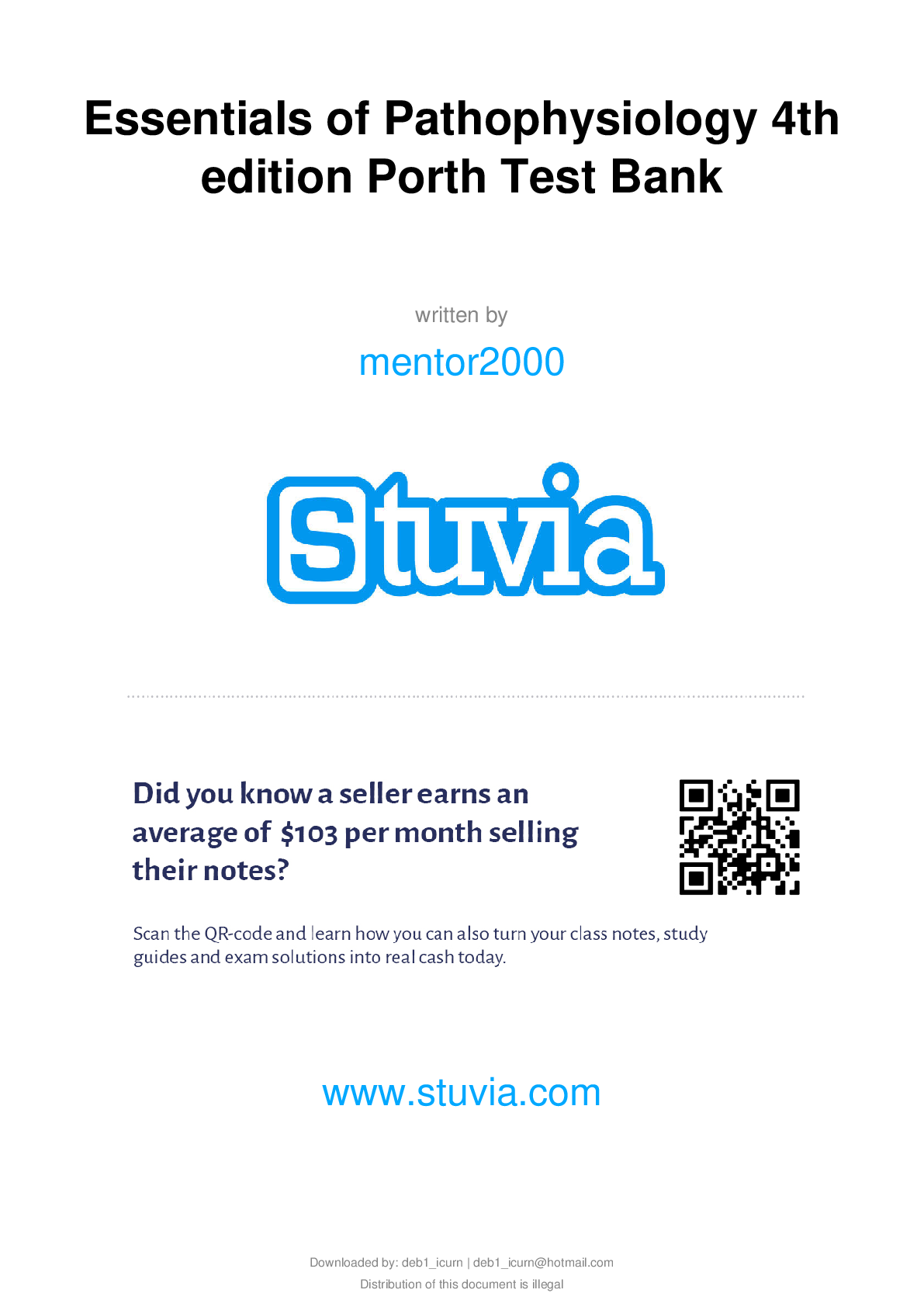

.png)
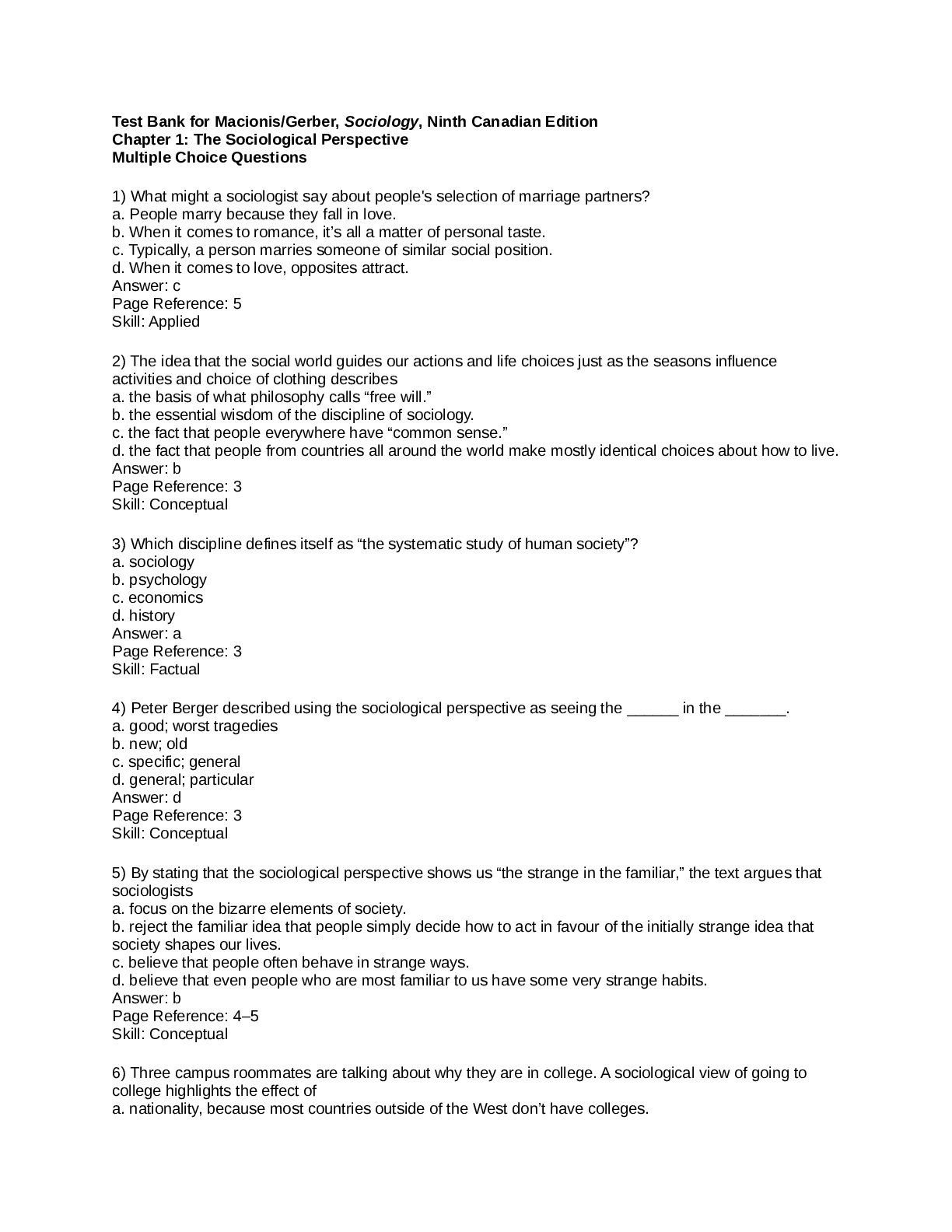
.png)
.png)
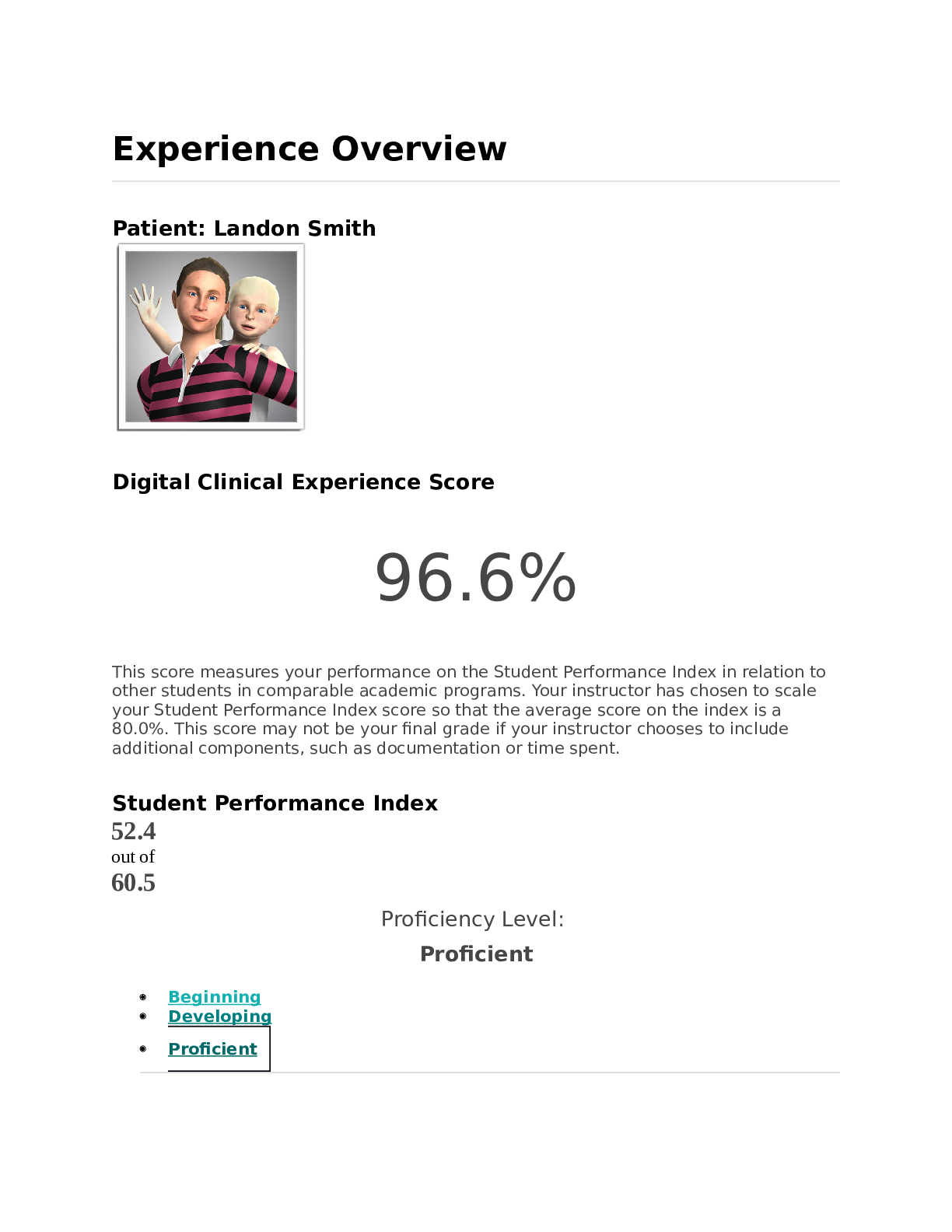
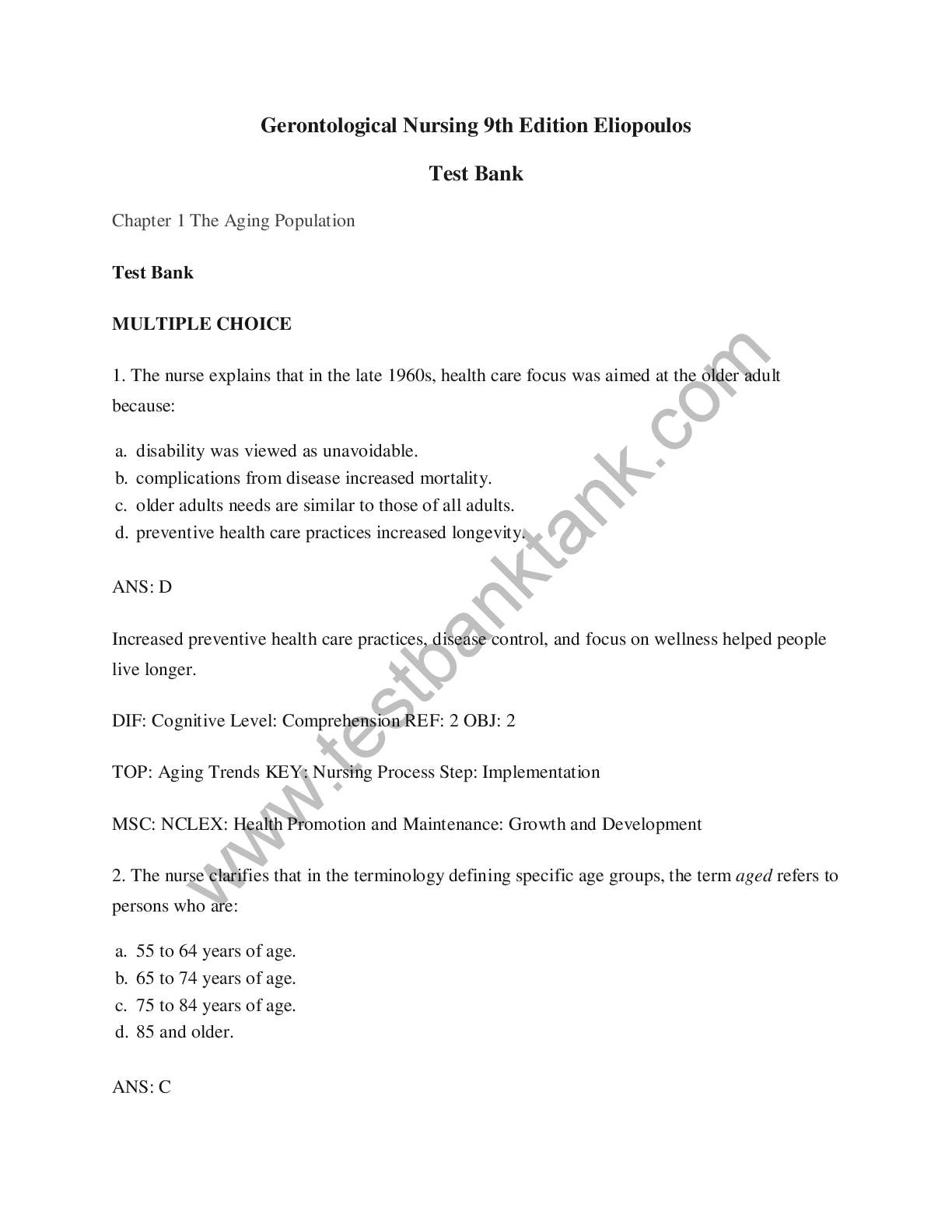

.png)
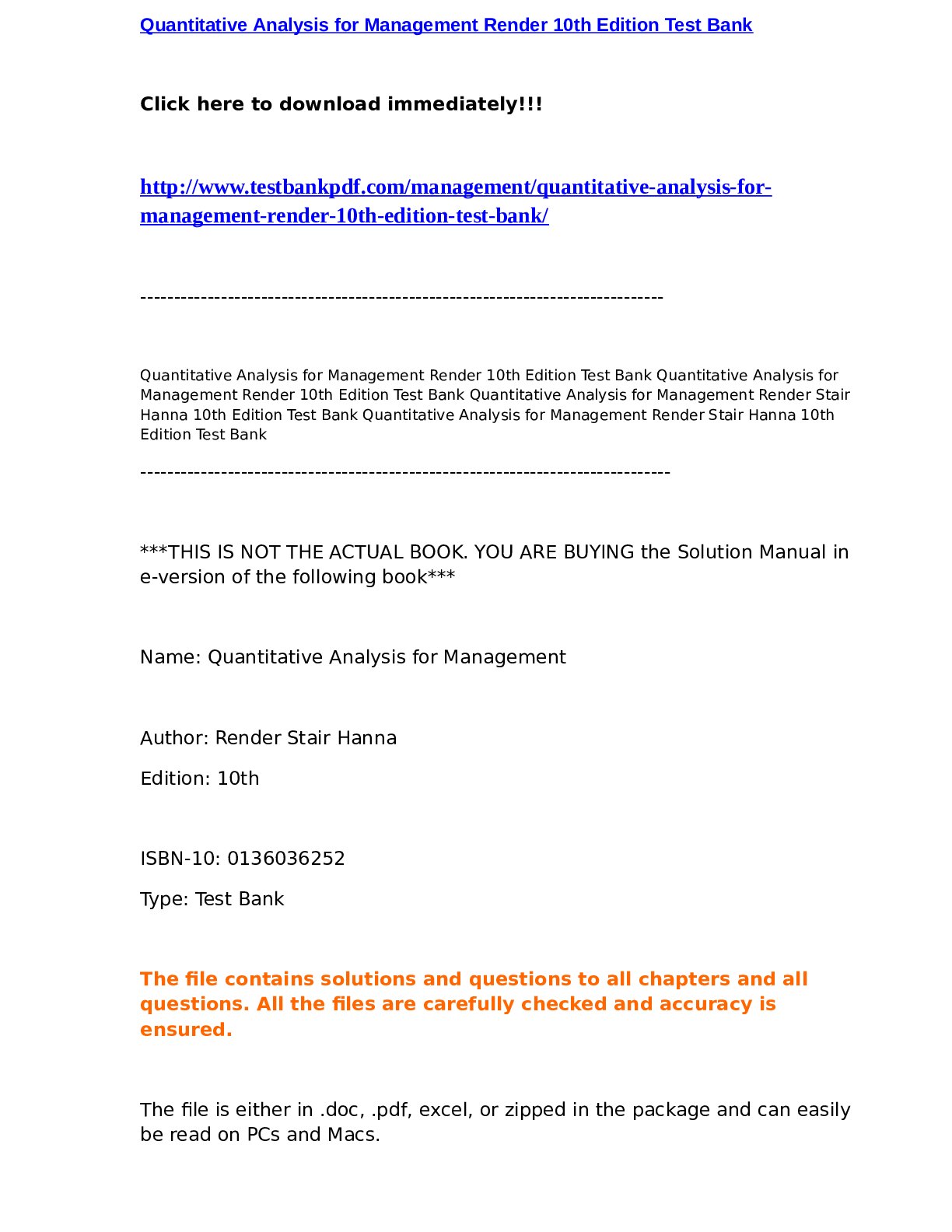
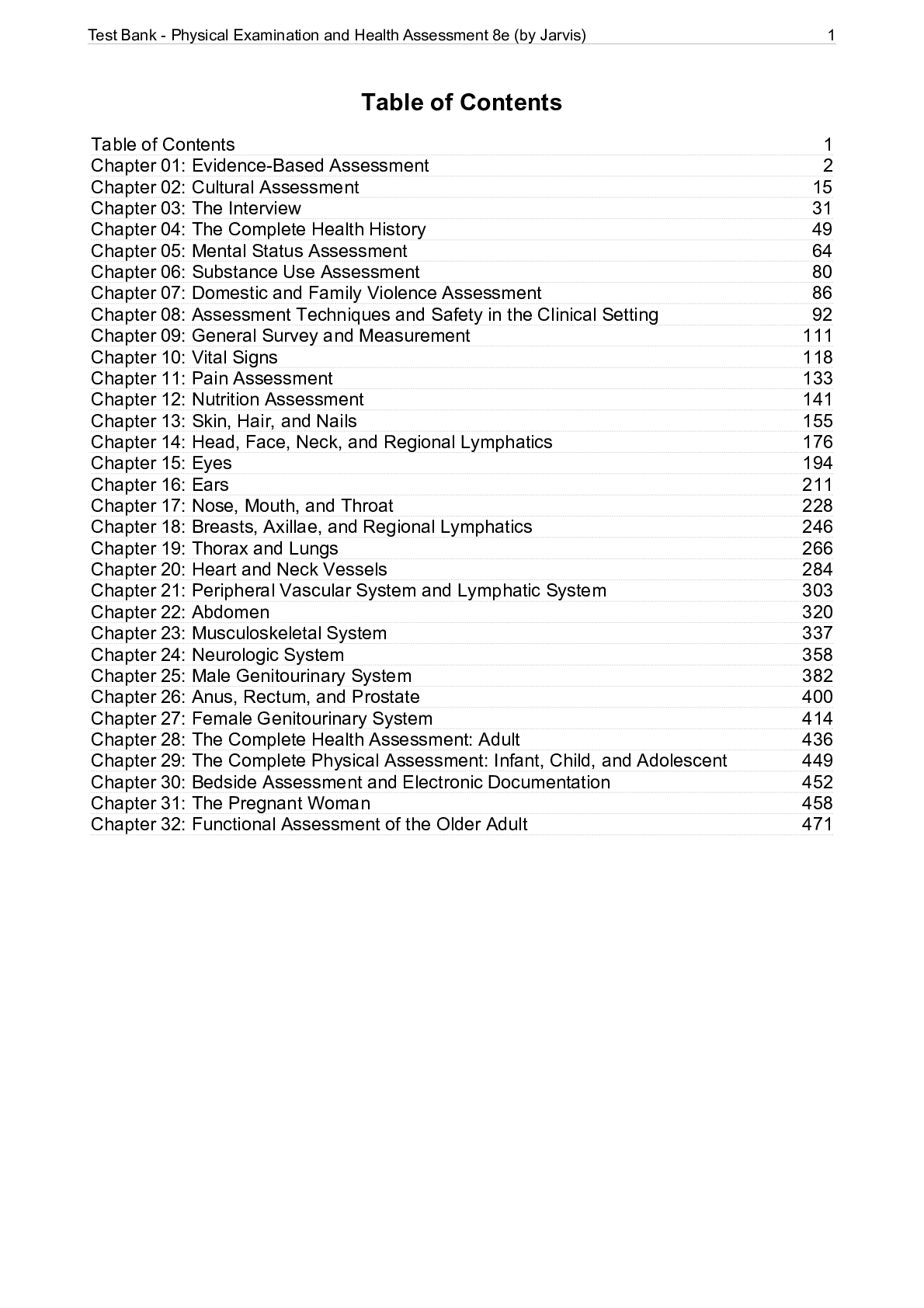

.png)
.png)


.png)


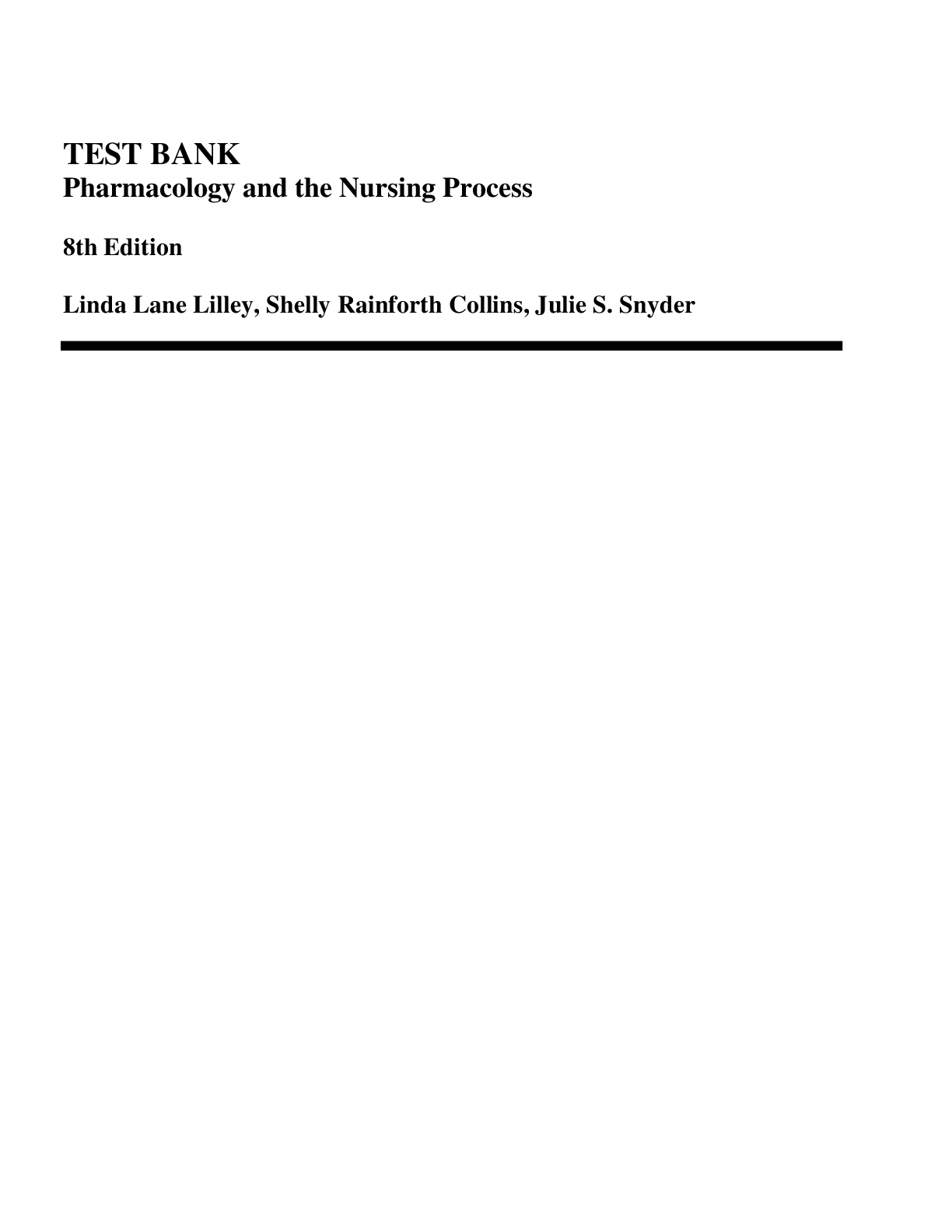

.png)

.png)
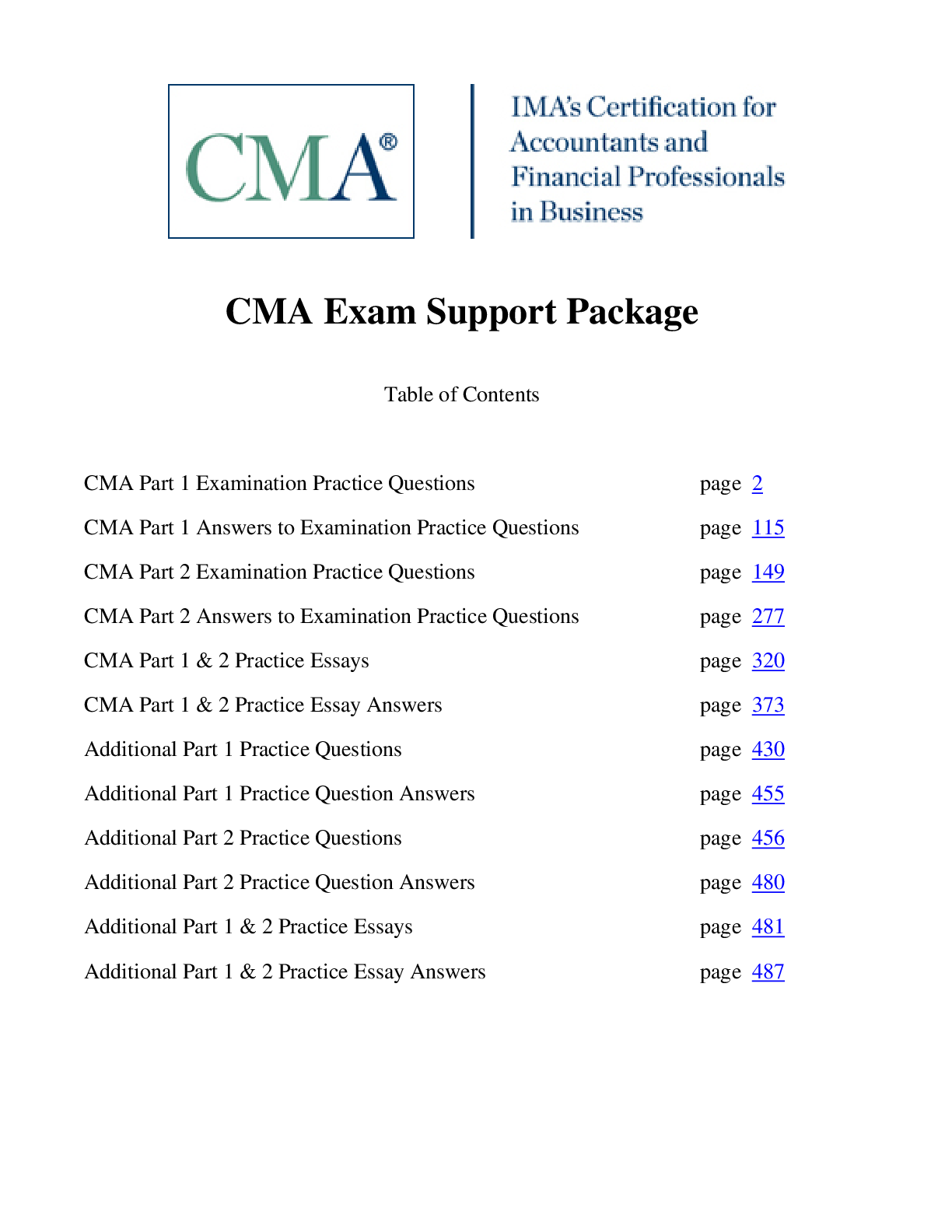








.png)

